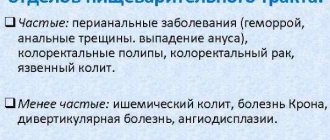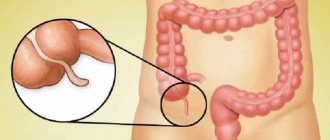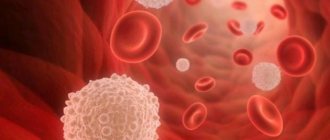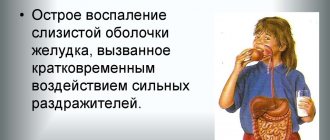The first sign of appendicitis in men, women and children is abdominal pain
The main and main symptom of appendicitis in the classic location is constant stabbing (sometimes aching) pain
, which begins suddenly, without a clearly defined cause, often in the afternoon.
Initially, characteristic pain is felt in the navel area and above (this is the epigastric zone), then a change in the nature of the pain is observed, they become more pronounced, intense and are localized on the right side in the iliac region (in the lower abdomen on the right).
A person in this condition cannot walk easily. As with walking, when coughing and laughing, a person experiences attacks of severe acute pain. The only thing the patient can do is lie in a certain position on the right side or on the back, otherwise the pain will increase significantly.
If the location of the appendix is atypical (retrocecal appendicitis occurs in 5%-12% of cases, and pelvic appendicitis in 8-19%), then pain from the epigastrium (the so-called peri-umbilical region) is shifted not to the lower right abdomen, but to the groin area, to lower back or hypochondrium, depending on the location of the appendix. Although at first, as with ordinary appendicitis, constant, stabbing pain suddenly occurs, in these cases there is often a slow increase in symptoms, they are weakly expressed, which is why the clinical picture of the disease is not bright.
If the appendix is located in the pelvis (the cecum is located in the pelvic area and is often close to the bladder and rectum), it may hurt in the area above the pubis. The pain is unpleasant and similar to that observed with inflammation of the genitourinary system.
Important! If the pain sharply subsides and disappears, this may indicate the beginning of the process of necrosis of the nerve cells of the walls of the appendix. This is a sure sign that there will be peritonitis (which is accompanied by very severe pain, weakness, fever and even loss of consciousness), which leads to complications and even death. Therefore, if you suspect appendicitis, you should urgently call an ambulance.
Gangrenous appendicitis: complications after surgery
If it is possible to identify and operate on gangrene of appendicitis before perforation of the intestinal appendix, then the possibility of dangerous consequences occurring is minimal. The most common complications in this case are infection and suppuration of the suture after appendectomy. They are easy to treat and do not require repeated surgery.
If the patient went to the doctor too late or the history of the disease led to a ruptured appendix, the consequences can be much more severe:
- A breakthrough in the wall of the intestinal appendix with the release of pus and feces into the peritoneal cavity.
- Self-amputation of the appendix (complete separation from the cecum).
- Multiple local abscesses in the pelvic area, under the diaphragm or in the intestines.
- Appendicular infiltrate (accumulation of inflamed processes around the appendix). The only contraindication to surgery is that removal of the appendix is possible only after 3-4 months, after complete resorption of the infiltrate.
- Purulent peritonitis. It poses a threat to the patient's life and requires immediate surgery.
- Septic thrombophlebitis.
Gangrenous appendicitis is the most insidious type of acute appendicitis, which can lead to serious problems if misdiagnosed. The most common consequence of this disease is rupture of the appendix followed by an abscess or peritonitis. Knowledge of all the symptoms of this disease, the ability to suspect a dangerous diagnosis in time and immediate surgery will allow you to avoid all complications of appendix gangrene and bring recovery as close as possible.
Stages of development or types of appendicitis
The general period for the development of appendicitis is 48 hours or two days. After this, inflammation leads to serious complications, which is life-threatening.
The classification of forms of acute appendicitis according to the degree of its development is as follows:
- Classic appendicitis begins with the emergence of favorable conditions for the development of pathogenic microflora, resulting in an inflammatory process on the mucous layer of the inner walls of the appendix. This is the catarrhal stage, in which the symptoms are hidden. It turns into a superficial form, when the focus of inflammation is already visible. The initial stage lasts during the first 12 hours of the attack.
- The second phlegmonous stage is when developing destructive changes begin to appear, leading to inflammatory processes in all tissues of the walls of the appendix. After this, the peritoneum becomes inflamed and its irritation causes the main symptoms or manifestations of the disease. The first sign is characteristic pain in the right iliac region. It happens that the formation of several foci of inflammation occurs, then they speak of phlegmonous ulcerative appendicitis. This stage lasts about 36 hours and begins on the second day after the onset of the disease. During this time, removal of appendicitis does not lead to serious consequences and is easy for a person.
- The gangrenous form is an advanced destructive stage of the lesion, when due to necrosis (death) of the tissues of the appendix, a loss of sensitivity occurs and the person’s constant pain disappears. The next perforation stage - perforation (rupture) or perforation of the walls leads to purulent peritonitis (pus comes out of the appendix and enters the abdominal cavity). This is accompanied by the sudden appearance of acute pain, and if surgery is not performed urgently, death occurs.
Chronic appendicitis occurs in 1% of cases, more often in young women. In this disease, inflammation of the appendix is gradual and slowly developing. The main symptom is increased pain in the right iliac region during physical activity, during tension of the abdominal muscles during bowel movements or during coughing.
It happens that the symptoms of chronic appendicitis bother a person for several years. The disease can become acute throughout this period. In this case, conservative treatment is used to relieve inflammation, swelling and restore blood circulation (taking antibiotics, diet and nutrition according to the clock)
During periodic exacerbations, nausea and vomiting appear, as well as stool disorders (constipation or diarrhea) and other symptoms of acute appendicitis. For treatment, surgery is performed to remove the appendix (appendectomy).
Causes
Gangrenous-perforated appendicitis is one of the stages of inflammation of the appendix. The reason why the appendix becomes inflamed is artery thrombosis. The next stage is the development of harmful bacteria in the intestinal microflora.
The danger is:
- cocci;
- bacteroides;
- coli;
- enterococci.
Destructive changes characteristic of the initial stage of inflammation of appendicitis:
- Reduced protection of the mucous membrane of the appendix and local immunity.
- Disturbances in the outflow of digestive tract contents from the appendix.
- Loss of elasticity of the walls of the appendix.
As the disease develops into a severe - gangrenous stage, the patient's condition deteriorates sharply. Sometimes gangrenous inflammation occurs without previous stages, as an independent disease.
This is due to:
- Circulatory disorders in the appendix.
- Lack of fiber in the daily diet.
- Formation of cholesterol plaques in the gastrointestinal tract.
- Vessel thrombosis of the appendix.
These data indicate that the main reason for the development of complications is poor circulation in the appendix. Other factors: infections associated with the development of harmful microflora, impaired outflow of food masses and immune autoaggression - are secondary factors and contribute to the development of gangrene, but do not provoke it.
Delayed assistance leads to purulent melting of the walls of the appendix, and the patient dies.
The most common causes of appendicitis and its prevention
Possible causes of appendicitis:
- Mechanical blockage of the lumen of the appendix with fecal stones due to constipation (more precisely, due to stagnation of feces) or blockage by parasites (ascariasis, amoebiasis).
- The presence of cancerous tumors or other neoplasms in the lumen of the appendix
- Impaired blood supply to the appendix due to thrombosis
- Deformation of the appendix due to the individual characteristics of its structure
- Displacement of the appendix during pregnancy in women
- Transfer of infection to the appendix from inflamed organs of the female genitourinary system (ovaries, appendages, etc.)
- Bacteria entering the appendix due to dysbacteriosis, diarrhea or increased gas formation (flatulence), as well as other infectious diseases
Prevention of appendicitis:
- Proper nutrition means having enough vegetables and fruits in your food.
- Treatment for parasites,
- Treatment for constipation, dysbiosis, indigestion and other gastrointestinal disorders
- Timely treatment of infectious diseases
Recovery after surgery for gangrenous appendicitis
After gangrenous inflammation of the appendix, particularly careful recovery after surgery is necessary, especially for the elderly and children. Comprehensive treatment and strict adherence to medical recommendations will prevent complications and speed up recovery.
The main therapeutic methods after removal of purulent appendicitis are:
- Taking antibiotics of various groups (ornidazole, cephalosporins, amikacin).
- Painkillers.
- Powerful detoxification treatment (plasma, saline solutions, glucose, etc.).
- Daily blood tests to identify any possible complications in time.
- Regular dressings (changing the dressing, washing the drainage tube and scar). Helps prevent suppuration and infection of the suture.
- Prevention of ulcers and blood clots (anticoagulants, gastric secretion blockers, elastic bandages).
- Breathing exercises and physical therapy. They help avoid complications such as intestinal obstruction, as well as cardiovascular and respiratory problems after appendectomy.
Symptoms in adults with appendicitis
Changes in the clinical picture in adults hourly
| Symptom | Stage I Catarrhal (first 12 hours) | Stage II Phlegmonous (from 12 to 48 hours) | Stage III Gangrenous (after 48 hours) |
| Appetite and general condition of the body | The earliest sign is loss of appetite and general discomfort. Bad dream. | No appetite. A person can only lie on his right side, or lie on his back. | A condition of the body similar to severe intoxication due to food poisoning |
| Pain | Initially, the pain is mild in the epigastric region (near the navel). If the pain is very severe from the very beginning, this indicates a serious circulatory problem in the appendix due to thrombosis of the appendicular artery. | Intensification and localization of pain in the right lower abdomen. | Very strong. Then, due to the death of nerve cells, the pain subsides. If appendicitis bursts or perforation of the appendix occurs and its contents are released into the abdominal cavity (the infection spreads to the abdominal cavity), this is manifested by sharp pain. |
| Weakness | Minor | Stronger | It's impossible to do anything. Severe weakness can lead to loss of consciousness. This is a very dangerous condition. |
| Body temperature | Normal or subfebrile temperature (37.3˚С – 37.5˚С) | Increase to 38˚C (according to Widmer's symptom, the temperature in the right armpit is slightly higher than in the left). During inflammatory processes, the temperature in the rectum is approximately 10 degrees higher than in the armpit | High (from 38˚С – 40˚С). May lead to hyperthermia or fever |
| Language | There is no dry mouth; there is a specific white coating at the base. | Not dry, all white | The tongue is dry and all white |
| Nausea and vomiting | 6 hours after the onset of the attack, nausea appears and the gag reflex is weak. | Vomiting once or twice indicates the development of destructive changes. It does not provide relief and, in fact, is the body’s reflex response to pain. | |
| Dry mouth | No | Begins | Strong |
| Chair | Defecation disorders (constipation, sometimes diarrhea, diarrhea, flatulence, bloating, loose stools) With a pelvic location of the appendix - frequent loose stools with mucus and blood | ||
| Urination | An increased urge to urinate (dysuria) if appendicitis is located near the bladder | ||
| Pulse | Violated if concomitant diseases are present | 80-85 beats/min. | Rapid (tachycardia) |
| Pressure | Blood pressure increases if there are concomitant diseases that are aggravated by appendicitis. For example, shortness of breath occurs (difficulty breathing) | Increased | |
Features of symptoms during pregnancy
Appendicitis in pregnant women is also not uncommon. About one in a thousand expectant mothers have to deal with this problem. Most often, this disease develops during the first two trimesters.
If a woman carefully monitors her condition, then it will not be difficult for her to notice that something is wrong. So, nausea, vomiting, problems with appetite are inevitable companions of pregnancy. But when the body is healthy, they go, so to speak, according to a certain schedule.
If appendicitis begins, then vomiting does not occur at the usual time, nausea becomes much stronger, appetite disappears completely, and all this is accompanied by severe pain in the navel area, which gradually shifts to the right side. If you lie on your right side, the pain intensifies significantly. Waves of pain are accompanied by vomiting.
The most striking symptoms will be fever, unusual sweating, and severe pallor.
Symptoms of appendicitis in children
The total time for the development of the disease in children is much shorter than in adults and lasts 24–36 hours. The table below provides information on the manifestations of the disease at three main ages when appendicitis is likely to occur. Appendicitis practically does not occur in one-year-old children, and in adolescents (from 11 to 18 years old) the symptoms are similar to those of the disease in adults.
| Symptom | In children under 3 years of age | In children from 3 to 6 years old | In children from 7 to 10 years old |
| Feature of age | Can't tell where it hurts. | Can tell where it hurts, but may ignore mild pain and not tell parents. | A child may be afraid to tell their parents about stomach pain because they are scared. |
| Loss of appetite | Refusal to eat is identified as the earliest sign of appendicitis in children | ||
| General condition of the body (weakness) | The child is lethargic, something is constantly bothering him (poor sleep), sharp monotonous crying. | Weakness. Unreasonable irritation and crying. | Weakness. |
| Pain | I have a stomachache. The pain intensifies when bending to the right. The child cannot lie on his left side. Painful sensations when walking. When you press, the pain subsides, but if you release your hand, it intensifies. | The stomach hurts, the nature of the pain, the child is not able to say | At first the whole abdomen hurts, then after 2-3 hours in the classic case it spreads to the lower right half. The pain intensifies when bending down. |
| Body temperature | Up to 40˚С | 38˚С – 39˚С | Up to 38 ˚С (chills) |
| Language |
| ||
| Nausea and vomiting | Nausea and repeated vomiting occur | Vomiting 1 – 2 times | |
| Dry mouth | Present at the last stage of the disease (the child is thirsty) | ||
| Chair | Liquid (sometimes with mucus), causing dehydration. | Bloating (flatulence or increased gas production), stool retention, but not constipation | Constipation is rarely present |
| Urination | Painful | Normal | Normal in a typical case (or frequent, with a pelvic location) |
| Pulse | Above normal | “Symptom of toxic scissors” Pulse does not correspond to body temperature. It is usually higher than normal. Normally, the pulse should increase by 10 beats/min. with a temperature increase of 1˚C | |
| Child behavior | The small child does not allow himself to be examined and pulls his right leg towards him. | Restless | Weakness |
Important! If a child has a stomach ache for 6 hours, has a fever and other signs of appendicitis, it is necessary to immediately consult a doctor.
Diagnosis of appendicitis - symptoms by authors
Diagnostic measures begin with the doctor receiving data about the patient’s complaints and conducting an examination. What methods are used to make a diagnosis of appendicitis? Below are the symptoms by author and a little information about how they are tested.
| Author of the clinical symptom | How to check | When the symptom is positive (appendicitis is diagnosed) | Scheme |
| Shchetkin Bloomberg | The doctor presses with his right hand on the right iliac region, then abruptly releases the hand. | The person feels severe pain when the doctor releases his hand. | |
| Kocher's (pain migration symptom) | The most important symptom. The pain begins in the epigastric region (near the navel) and moves to the lower right half of the abdomen | ||
| Voskresensky (shirt symptom) | The surgeon pulls the patient's shirt down with his left hand. The patient takes a deep breath, and the doctor at this moment makes a sliding movement with his fingers from the epigastric region to the right side. | When stopping the movement of the arm at the very end, without lifting it from the abdominal wall, a sharp pain appears | |
| Barthomier–Mikhelson | The patient lies on his left side. The doctor presses on the place where the appendicitis is located. | Pain increases during palpation | |
| Rovzinga (Rovsinga) | The surgeon presses his fingers on the left iliac region of the abdomen, and at the same time pushes along the rectum with his right hand. The movement of gases in the colon causes irritation of the appendage. | Pain appears in the right iliac region (irritation of the inflamed appendix causes pain). | |
| Razdolsky (Mendel) | The patient lies on his back. The person conducting the examination lightly taps the anterior abdominal wall in the right iliac region with his fingers. | Pain appears. | |
| Sitkovsky | The person lies down on his left side. | Pain appears or intensifies in the right iliac region. | |
| Ivanova | The distance from the navel to the most protruding part of the pelvis on the left and right is compared. | Right is smaller than left | |
| Ostrovsky | In the supine position, the patient’s straight right leg is raised at an angle of 130˚C and held in this position, and then sharply released. | Pain in the right iliac region. | |
| Aaron | The doctor presses on the right iliac fossa | There is a feeling of fullness in the epigastric region | |
| Volkovich | The patient leans to the left side | Pain intensifies in the area of the appendix | |
| Krymova | The doctor palpates the external opening of the inguinal canal | Pain appears in the lower right half of the abdomen | |
| Obraztsova | Used to diagnose acute retrocecal appendicitis. The patient, lying on his back, raises his straight right leg. | Painful sensations appear | |
| Cope | Used to diagnose pelvic appendicitis. There are two ways to check for this symptom:
| Pain appears at the site of appendicitis | |
| Gabay | Similar to Shchetkin Blumberg’s symptom (first they press and then sharply release the hand) only palpation is carried out in the lower back area of the Petite triangle | A characteristic pain appears on the right side | |
| Yaure Rozanova | Used only for atypical (retrocecal) location of the appendix. The doctor presses his finger into the so-called "Petit" | Soreness appears | |
In men, appendicitis is also manifested by slight tightening of the testicle on the right side during examination by palpation. Gently tugging on the scrotum also causes pain in the right testicle.
In women, diagnosis becomes much more difficult if the attack began during menstruation.
Important! To make a diagnosis, it is necessary to see the complete clinical picture. Therefore, if appendicitis is suspected, the patient needs to see a doctor and urgent hospitalization for a more thorough examination. This cannot be done at home.
In the hospital, to determine the disease, it is necessary to take a general blood and urine test. Rarely does a surgeon prescribe a rectal examination (only in cases of low pelvic position) or quite often a vaginal examination (in women this excludes the presence of gynecological and urological problems). If the picture is unclear, additional consultation with a gastroenterologist and gynecologist is often necessary.
If a general blood test shows an increased number of leukocytes in the blood (above the norm of 9 in the absence of pregnancy in women), this indicates the presence of an inflammatory process. If it turns out that this indicator exceeds 20, there is a possibility of ruptured appendicitis (peritonitis). Leukocytosis is observed in 52% of cases. Otherwise, medical experts say that it may be latent appendicitis (the history or symptoms of this disease are somewhat different). The amount of C-reactive proteins in the blood also indicates the presence of inflammation (the norm in adult men and women is 10 mg/l; levels above the norm may indicate an inflammatory process, with the exception of pregnant women, for whom the norm is 20 mg/l). Reactivity indicators increase 12 hours after the onset of the attack.
A general urine test in 25% of cases (with pelvic and retrocecal appendicitis) shows the presence of a small number of retrocytes and leukocytes.
If this is not enough and it is not possible to accurately diagnose appendicitis, in addition to tests and examination of the patient by a surgeon, a number of instrumental studies are carried out for further diagnosis and detection. More often, ultrasound of the pelvic organs and laparoscopy. Unlike ultrasound, the laparoscopic method allows you to accurately determine the presence or absence of pathology, and if the diagnosis is confirmed, the appendicitis is immediately removed. Laparoscopy is most often performed under general anesthesia, so it has a number of contraindications.
Diagnostic measures
Diagnosis begins with palpation of the iliac region. Here the degree of tension in the abdominal wall and its pain is determined. Another characteristic sign of inflammation of the appendix is the Shchetkin-Blumberg symptom. To determine it, the doctor carefully presses on the patient’s stomach and removes his hand with a sharp movement. The occurrence of severe pain is characterized by the presence of an inflammatory process in the appendix.
Sometimes temperature readings in the armpit and rectum are used for diagnostic purposes. The presence of appendicitis will be manifested by a difference of 1 degree.
Finger palpation of the rectum and vaginal walls in women helps to “find” the location of the appendix. This measure is especially relevant for patients. It is needed to eliminate inflammatory processes in the female reproductive system.
What are the dangers of appendicitis and its complications?
Appendicitis is dangerous due to its complications, or rather their consequences. Many of them pose a threat to human life and health. Therefore, the most important thing in the successful treatment of pathology and reducing the risk of death is timely access to a doctor and early diagnosis.
The most common complications of appendicitis are:
- Peritonitis is when appendicitis bursts (due to perforation or rupture of the wall of the appendix) and pus enters the abdominal cavity and the inflammatory process spreads, causing purulent abscesses (formation of ulcers or fistulas on the internal organs of the abdominal cavity), the consequences of which are general blood poisoning ( sepsis) and death. Most often, the lesion affects the peritoneum and some parts of the intestine. The first signs of peritonitis are severe pain, dry mouth and fever. Since the affected areas of the intestine will also need to be removed surgically, surgery to remove peritoneal appendicitis is much more serious and leads to problems such as intestinal adhesions and intestinal obstruction.
- Appendiceal infiltration is a serious complication that leads to chronic appendicitis. A dense pathological formation forms around the process. This is the body’s protective reaction to the appearance of a foreign organ. It is very difficult to remove this formation.
- Pylephlebitis is the most dangerous condition when the disease quickly affects the main vessels of the liver, they become inflamed, and the blood supply to the organ is disrupted, which, in most cases, results in death.
The number of fatalities (cases of death) from appendicitis increases significantly in critical cases of admission to the hospital of patients requiring emergency care with advanced disease in the late stages with complex peritonitis or pylephlebitis.
Important! If you suspect appendicitis, be sure to immediately contact an ambulance, regardless of your location! This measure can save lives! Before a medical examination, you should not use a heating pad, give painkillers or laxatives.
Why is it difficult even for doctors to diagnose appendicitis?
Despite a fairly large number of characteristic symptoms, diagnosing appendicitis often causes difficulties even for experienced doctors. The fact is that the first signs of the disease are varied, and the body structure of each person is absolutely individual, and there is no clear answer to the seemingly simple question “on which side is a person’s appendix?” simply doesn't exist. In most cases, the appendix is located in the lower right side of the abdomen, but quite often it is located higher, and sometimes it can be in the liver area. There are also cases where the appendix is located on the left side.
Like all other organs of the digestive system, the appendix is attached to the wall of the abdomen with the help of a special organ - the mesentery. In some people, the features of the mesentery are such that they allow the appendix to become dislodged.
In addition, the size of the appendix itself can vary greatly from person to person: its thickness varies from 0.5 to 1 cm, and its length from 0.5 to 23 cm.
Additional complications are created by the fact that the appendix can be located near completely different organs: behind the colon, among the pelvic organs (this is typical for women), near the gallbladder. Therefore, inflammation of the appendix (appendicitis) may look like inflammation of completely different organs.
The picture becomes even more confusing when we consider the fact that many other diseases can mimic a full-blown attack of appendicitis, although the appendix itself is completely healthy. This is due to the same tightness in the abdominal cavity. The organs are located literally close to each other, and the symptoms are confused.
More often than others, an attack of appendicitis is imitated by the following diseases.
- Meckel's diverticulitis. A small protrusion of the ileum (called a Meckel's diverticulum) is a congenital abnormality that occurs in approximately 2% of newborns (boys are twice as likely to suffer from it as girls).
- Inflammation of the pelvic organs (rectum, bladder, a number of gonads). Quite often, gynecological diseases such as inflammation of the ovary and inflammation of the fallopian tube give a picture characteristic of appendicitis.
- Inflammatory diseases of the organs of the right upper abdomen. The pain often radiates downwards, and even to an experienced specialist it may seem that a person has appendicitis. More often than others, such “deceivers” are perforated duodenal ulcer, cholecystitis, and liver abscess.
- Diseases of the right kidney. This organ is a close neighbor of the appendix, so the manifestations of nephritis are very easy to confuse with appendicitis.
- Ectopic pregnancy.
Treatment of appendicitis - emergency appendectomy
Treatment for appendicitis is emergency surgery to remove it or appendectomy. Surgery is performed either through one large incision (7-10 cm) or through three small incisions (1-2 cm) laparoscopically under general anesthesia.
In order to determine the location of the incision, they are guided by the Mac Burney point.
The earlier the disease is diagnosed, the easier the operation is for the patient.
There are often cases when the surgeon already during the operation becomes aware that there is no appendicitis, then intraoperative differential diagnosis is used. During laparoscopy, special attention is paid to gynecological pathologies.
A case from one's life. One patient underwent laparoscopy. During the examination, it was discovered that appendicitis was combined with ovarian rupture.
In most cases, the prognosis is positive; difficulties arise in cases where:
- elderly age
- the presence of a large number of concomitant chronic diseases (serious diseases of the heart, kidneys, liver and other internal organs)
- advanced stage of the disease.
Complications after appendectomy may include:
- Internal bleeding
- Postoperative inguinal hernia (depending on the patient)
- Formation of infiltrates
- Internal abscesses
- Supuration of sutures due to infection
- Adhesive processes in the intestines leading to the formation of fistulas (after removal of appendicitis with diffuse peritonitis)
- Intestinal obstruction (a person suffers from severe pain and other dangerous consequences)
Gangrenous appendicitis causes
Acute appendicitis in its development goes through several stages and is divided into catarrhal and purulent (phlegmonous, gangrenous and perforated). In most cases, they speak of secondary gangrenous appendicitis - it occurs on the 2-3rd day of illness in the absence of medical care, in rare cases - after 6-12 hours. In children, gangrene of the appendix develops especially quickly.
In rare cases, the medical history records the primary type of purulent inflammation of the appendix. The following reasons can provoke this form of the disease:
- Damage to the walls of blood vessels in old age.
- Atherosclerosis of the intestinal arteries (cholesterol plaques on the walls).
- Congenital underdevelopment (hypoplasia) of the appendicular arteries in children.
- Thrombosis of the veins and arteries of the cecum.
Vascular problems cause circulatory problems, resulting in death of appendix tissue. Acute purulent appendicitis can also be accelerated by reasons such as various infections and autoimmune processes in the intestines.
Postoperative period
Immediately after an appendectomy, you need to lie down for about 12 hours, and you cannot eat or drink. If necessary, a special drainage tube is installed at the incision site, which is necessary to drain internal fluid and administer antibiotics. It is removed already on the third or fourth day. The doctor will prescribe painkillers for some time after the operation.
In the second half of the first day you can drink a small amount of acidified water.
On day 2, you can eat a little low-fat kefir or cottage cheese. It is already necessary to try to get out of bed and slowly walk. In active patients, the body's recovery proceeds faster.
The sutures are removed 7–10 days after surgery.
You need to stick to a diet for about a week and a half, and then you can gradually introduce your usual diet.
During recovery, you should wear a compression bandage and reduce any physical activity (in no case should you lift heavy objects).
Important! The postoperative period after appendectomy for simple appendicitis lasts from 20 days to a month. If the operation was performed on an elderly person or appendicitis with peritonitis was removed, then it may take up to six months for the body to fully recover.
At this time, in order to avoid complications, you must follow all recommendations and be sure to come to see a doctor.
Treatment of acute appendicitis
Removal of the inflamed appendix is a generally accepted treatment strategy. When the appendix is removed at an early stage of the disease, a minimally invasive laparoscopic operation is performed. If symptoms of peritonitis develop, abdominal surgery is indicated. Sometimes the operation begins with laparoscopy and ends with abdominal surgery (when the inflammatory process extends beyond the appendix).
The postoperative period averages 7-10 days and depends on the volume of surgery, the stage of the pathological process and postoperative complications. The earlier an appendectomy is performed (ideally at the catarrhal stage), the faster the patient can return to normal activities. Therefore, if you have the slightest suspicion of appendicitis, you should not delay visiting a doctor.
Conservative treatment is used extremely rarely for mild symptoms of appendicitis and intoxication and the presence of contraindications to surgery. If the process progresses, the appendix is removed in any case.
In the West, intravenous antibiotic therapy is practiced, which is started as early as possible (see uncomplicated appendicitis can be treated with medication). In our country, antibiotic therapy is indicated in the postoperative period.











